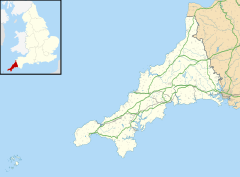Wheal Trewavas was a copper mine in Cornwall, England, about 1.5 miles (2.4 km) west of Porthleven. The ruined engine houses remain, on sea cliffs overlooking Mount's Bay, just east of Trewavas Head. The site is a Scheduled Monument.[1]
| Wheal Trewavas | |
|---|---|
 The two engine houses | |
| Location | near Porthleven, Cornwall |
| Coordinates | 50°5′25″N 5°21′28″W / 50.09028°N 5.35778°W |
| OS grid reference | SW 599 265 |
| Built | 1834 |
| Designated | 26 November 2004 |
| Reference no. | 1021324 |
History edit
The mine was in operation from about 1834 to 1846. It exploited four copper lodes, which ran south-east along the coastline.[1]
There are two engine houses. The building to the west served the first shaft, Old Engine Shaft, which was in operation by 1834. It housed an engine of cylinder diameter 18 inches, to pump water from the mine. To the east, New Engine Shaft began operation in 1836; it had a 45-inch engine.[2][3][4]
The mine employed about 160 men, and the workings extended under the sea. The mine was successful; it brought up about 17,500 long tons (17,800 t) of copper.[2][3]
Closure of the mine edit
The mine eventually closed because of flooding.[1] There is a story that the annual dinner of the "tributers" was to take place in a tunnel under the sea; two men making final preparations to the tables noticed water leaking from the tunnel roof, and quickly left. The sea soon broke in, before the time planned for the dinner.[5]
Description edit
The engine house and chimney of Old Engine Shaft are situated on the cliffside, about 20 metres (66 ft) above the sea and about 40 metres (130 ft) from the clifftop. Adjoining the building is a capstan platform; during the operation of the mine, a manually operated capstan lowered equipment down the shaft. The chimney is separate from the engine house, and was built about 1840, replacing an earlier chimney. The engine house and chimney are both Grade II listed buildings.[6][7]
The engine house and separate chimney of New Engine Shaft are a short distance further east along the coast, near the top of the cliff. They are both Grade II listed buildings.[8][9]
Mineral Statistics edit
From Robert Hunt's Mineral Statistics of the United Kingdom[10].
| Year(s) | Ore (Tons) | Metal (Tons) | Value (£) |
|---|---|---|---|
| 1835 | 267.00 | 29.13 | 2273.20 |
| 1836 | 1339.00 | 122.84 | 11624.43 |
| 1837 | 1156.00 | 95.72 | 7208.73 |
| 1838 | 1025.00 | 87.39 | 6675.63 |
| 1839 | 1262.00 | 109.50 | 8183.78 |
| 1840 | 1849.00 | 147.72 | 11609.25 |
| 1841 | 2366.00 | 176.18 | 15659.93 |
| 1842 | 2775.00 | 209.87 | 16288.43 |
| 1843 | 2316.00 | 198.35 | 15023.18 |
| 1844 | 1607.00 | 127.27 | 9283.50 |
| 1845 | 977.00 | 73.15 | 5452.50 |
| 1846 | 397.00 | 33.38 | 2330.73 |
| 1857 | 18.00 | 0.72 | 68.40 |
See also edit
References edit
- ^ a b c Historic England. "Wheal Trewavas copper mine 310m south of Trewavas (1021324)". National Heritage List for England. Retrieved 5 September 2020.
- ^ a b "Wheal Trewavas" intoCornwall.com. Retrieved 5 September 2020.
- ^ a b "Wheal Trewavas Mine" The Cornwall Guide. Retrieved 5 September 2020.
- ^ D. B. Barton. Cornwall's Engine Houses. Tor Mark Press, 3rd edition 1999. Page 21.
- ^ "Wheal Trewavas" Helston History. Retrieved 5 September 2020.
- ^ Historic England. "Engine house and capstan plat at SW598265, Old Shaft, Trewavas Mine (1328350)". National Heritage List for England. Retrieved 5 September 2020.
- ^ Historic England. "Detached chimney at SW598263, Trewavas Mine (1142249)". National Heritage List for England. Retrieved 5 September 2020.
- ^ Historic England. "Engine house at SW600265, New Engine Shaft, Trewavas Mine (1311611)". National Heritage List for England. Retrieved 5 September 2020.
- ^ Historic England. "Detached chimney at SW600265, serving engine house at New Engine Shaft, Trewavas Mine (1142250)". National Heritage List for England. Retrieved 5 September 2020.
- ^ Burt, Roger; Burnley, Ray; Gill, Michael; Neill, Alasdair (2014). Mining in Cornwall and Devon: Mines and Men. University of Exeter Press. ISBN 978-0-85989-889-8.
